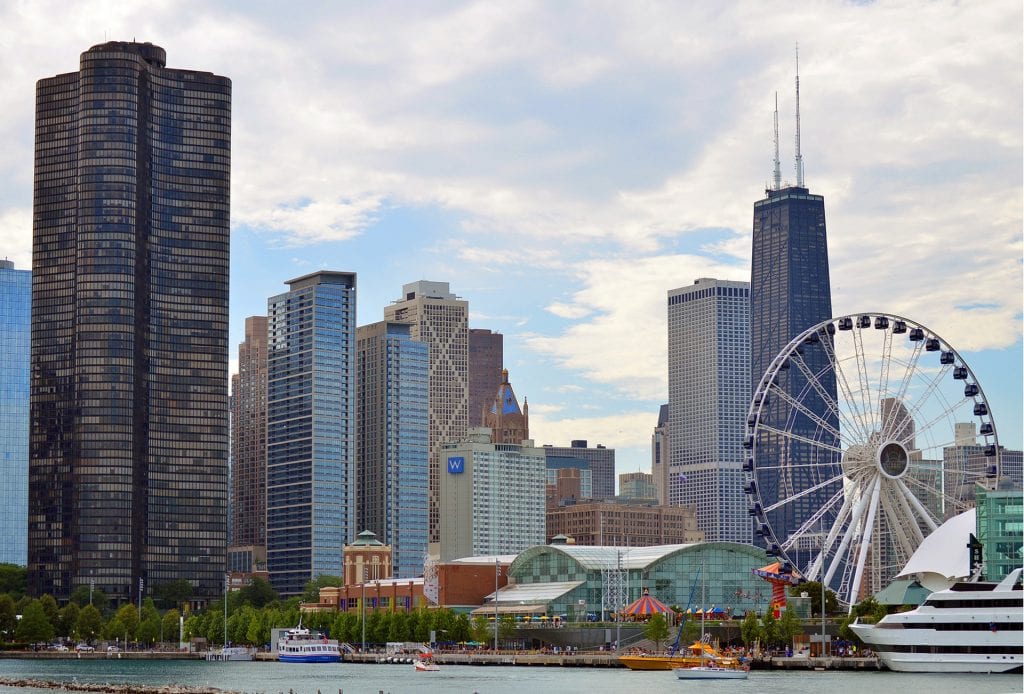Modern Day
Chicago was incorporated as a city in 1837 and is located on the shores of freshwater Lake Michigan. It is the third most populous city in the United States. As of the 2017 census-estimate, Chicago has a population of 2,716,450. It was the second most visited city in the United States with 55 million domestic and international visitors in 2017.
Chicago’s culture includes the visual arts, literature, film, theater, comedy (especially improvisational comedy), food, and music, particularly jazz, blues, soul, hip-hop, gospel, and electronic dance music including house. Of the area’s many colleges and universities, the University of Chicago, Northwestern University, and the University of Illinois at Chicago are classified as “highest research” doctoral universities.
City landmarks include Millennium Park, Navy Pier, the Magnificent Mile, the Art Institute of Chicago, Museum Campus, the Willis (Sears) Tower, the Museum of Science and Industry, and Lincoln Park Zoo.
Chicago South Side
We will be hosting our conference on Chicago’s historic South Side. It is the largest of the three regions of the city that radiate from downtown—the others being the North Side and the West Side (while there is no East Side, because Lake Michigan runs along the city’s eastern border, there is an East Side community area on the South Side, in the far southeastern section of the city).
The South Side was once known as Chicago’s “Black Belt”, and was where First Lady Michelle Obama grew up, then known as Michelle Robinson.
The South Side boasts a broad array of cultural and social offerings, such as professional sports teams, landmark buildings, museums, educational institutions, medical institutions, beaches, and major parts of Chicago’s parks system.
The South Shore Cultural Center is a 65 acre facility located in the South Shore community, It was formerly a country club but is now a cultural facility that has been recognized as a Chicago Landmark and is also listed on the National Register. Bought by the Chicago Park District in 1975, it was restored as a historic landmark in response to a community campaign. It is also known as the site of the wedding reception of our 44th President and First Lady, Barack and Michelle Obama, in 1992. Please visit our Getting Around page for a few recommendations on things to see and do while on Chicago’s South Side!
History
The name “Chicago” is derived from a French rendering of the indigenous Miami-Illinois word shikaakwa for a wild relative of the onion.
Prior to its rise as an international hub for finance, commerce, industry, technology, telecommunications, and transportation, the Chicago region served as home and trade center for various Native nations for thousands of years, including the Potawatomi, Miami, and Illinois, once powerful nations that experienced dramatic decline in the face of European expansion into their territories. The area that is now Chicago became part of the United States through a series of treaties from 1795 to 1833. The Town of Chicago was established on August 12, 1833 with a population of 200, with rapid growth soon thereafter due to its role as a transportation hub between the east and expanding western parts of the United States.
During the 1900s, many Native Americans moved from nearby reservations and other rural communities to Chicago in pursuit of jobs, housing, and other opportunities. This movement was fueled in part by a controversial “relocation program” run by the Federal government which resulted in the movement of thousands of people to major urban areas, including Chicago, during the 1950s and 1960s. Today, the Native American population of Chicago numbers less than 1%, with approximately 30,000 Native Americans currently residing in the entire state of Illinois, according to the U.S. Census.
The early part of the 20th Century was a time of increasing industrialization, and the Great Migration of millions of African Americans from the south to the urban north. Between 1910 and 1930 the African American population of Chicago increased more than fivefold, leading to the Chicago Black Renaissance and contributing to the “New Negro Movement” in art, literature and music. Gwendolyn Brooks, an eminent Chicago poet of the 20th Century was also from Chicago’s South Side, and in June of 2018, the City of Chicago honored her with a memorial statue in a park named after her, in Chicago’s South Side. Brooks was the First African American to receive the Pulitzer Prize (1950) and the first African American woman inducted into the Academy of Arts and Letters (1976).
Did You Know?
- The Taste of Chicago is the biggest outdoor food festival in the country, attracting tens of thousands of visitors every year.
- The nation’s first televised presidential debate took place in Chicago between JFK and Nixon in 1960.
- The nation’s largest collection of impressionist artwork calls Chicago home. The collection of various masterpieces range from early cultural art to modern American art.
- In 1893, Dr. Daniel Hale Williams performed the nation’s first open heart surgery at Chicago’s Provident Hospital. Dr. Hale Williams was also one of the city’s first African American surgeons.
- On April 15th, 1956 color television launched and brought Chicagoans their favorite TV channels in color. It was the first city to debut an all-color television station.
- In 1937, Chicago became the first city to establish a blood bank in the United States. We can thank Dr. Bernard Fantus for introducing this critical service at the Cook County Hospital.
- Chicagoan Jimmy Dewar created a cream filled pastry in 1930 known as – the Twinkie! Yum or yuck?


